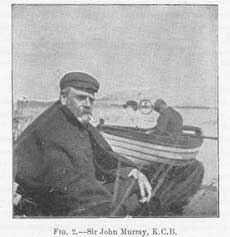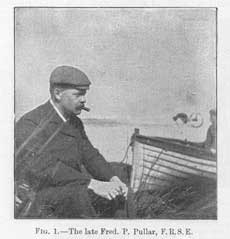Bathymetrical Survey of the Fresh-Water Lochs of Scotland, 1897-1909
Biographies
Sir John Murray (1841-1914)

Born in Coburg, Ontario, the son of a Scottish emigrant, John Murray left Canada for Scotland at the age of 17, attending Stirling High School and Edinburgh University. His main academic reputation was gained in the field of oceanography, and he took part in several famous scientific expeditions. Between 1872-6 he was on board HMS Challenger in her mapping and examination of the world's oceans, and from 1881 publishing the findings. Through Murray's efforts the Challenger Office, founded in Edinburgh, became an international centre for marine science as well as the office for the co-ordination of the Bathymetrical Survey. Murray also founded the Granton Marine Station, which went on to research and investigate the Firth of Forth and North Sea. Further afield, Murray went on to explore the sea bed off Spitzbergen and the Faeroe Islands, and in 1884, he researched the sea lochs on the west coast of Scotland in his own purpose-built yacht, Medusa.
During this research, that also took him into the Great Glen lochs, he was struck by the different biological and physical conditions that prevailed between salt and fresh water lochs. The subject warranted further study, and Sir John was fortunate that several other interested parties were also keen for a systematic bathymetrical survey to be undertaken, including physical scientists, geologists, fishermen, and engineers interested in water supply and hydro-electricity.
As described in the Background, the survey began slowly in 1897, but then speeded up dramatically after 1902, with all lochs surveyed by 1906. The final publication of the Bathymetrical Survey volumes in 1910 included Murray's account of the survey and a detailed essay by him on the characteristics and distribution of lakes across the world. Through Murray's academic stature, and his involvement of other respected scientists who were able to use his systematic, accurate new data on Scottish lochs, the Bathymetrical Survey was widely recognised internationally, and is still of major value today.
Sir John died four years after the publication of the Survey in March 1914, killed instantly when his car overturned near his house in Edinburgh's Granton area. He was buried in the Dean Churchyard in Edinburgh.
Frederick Pattison Pullar (1875-1901)

Fred Pullar was born in Bridge of Allan, by Stirling, the only son of Laurence Pullar, and he was educated at Stirling High School and Glasgow and West of Scotland Technical College in Glasgow. He initially entered the family garment cleaning and dyeing business, Pullars of Perth (still operating today). However, he was keenly interested in meteorology, mechanics, and mathematics, showing great promise in scientific studies, and widely regarded as being destined for great things.
Through his father's lifelong friendship with Sir John Murray, Fred accompanied Murray on some early experimental loch surveys in the 1890s, and amongst other things developed a more accurate sounding device, which became known as the F P Pullar Sounding Machine (Fig). Between 1897 and 1900, the two men surveyed 15 lochs, primarily in the Forth Basin, until tragedy struck early in 1901.
Whilst he was skating on Airthrey Loch, near Bridge of Allan, along with several hundred people, the ice suddenly gave way, and in the ensuing melee, Fred ably assisted three people to land. 'He then went to the succour of a young lady who was in an exhausted condition. It is confidently asserted by spectators ... that he might easily have saved himself had he relinquished his burden: this he refused to do.' (Murray & Pullar, 1910, vol. 1. p. 21). They both drowned and their bodies were recovered some three quarters of an hour later. He was buried in Logie Churchyard, in his 25th year, widely mourned by all who knew him.
The Bathymetrical Survey team
In the published volumes, nearly 50 people are listed who were at times employed on the Survey, including physicists, zoologists, biologists, surveyors, geologists, boatmen, and cartographers.
Were it not for the financial generosity of Laurence Pullar, Fred's father, the Survey would probably not have progressed beyond 1901. Indeed, following Fred's death, Sir John Murray intended to abandon the survey altogether, but was persuaded by Laurence Pullar to continue the work his son had shown such interest in. Laurence Pullar donated £10,000 into a trust fund to further the survey, provided he was assured the work would not be undertaken by any government department, that was important scientifically, and that it would be superintended by Sir John Murray. Such assurance was forthcoming, and Laurence Pullar became co-Director of the Survey with Murray, also substituting for his son as far as possible in practical matters.
Many experts worked for a period on the Survey, and a brief glimpse of the excitement (and also danger) of late 19th century scientific and geographic enquiry is sometimes reflected in the Survey report. For example Mr James Parsons, a chemist, left the survey in 1903 to work on the Mineralogical Survey of Ceylon, but lost his life in the jungle in 1909. Mr James Murray recorded extensive biological phenomena until 1907, when he left to take part in Shackleton's ill-fated Antarctic expedition. Benjamin Peach and John Horne, who went on to contribute substantially to our understanding of Scottish geology, wrote a detailed chapter, explaining how the Bathymetrical Survey had contributed to a fuller understanding of the formation of Scottish landscape. It is also appropriate that Dr J G Bartholomew, who strove hard to advance geographical and scientific understanding through his cartographic work, drafted and published all the maps of the Survey.
![]()
Introduction, facts and background | Soundings and Preparation of the Maps | Biographies
